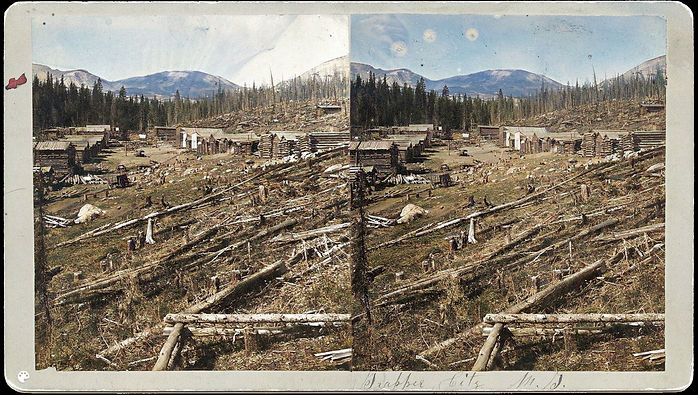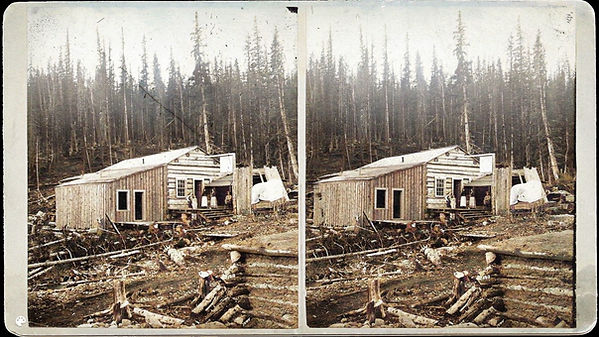Trapper City, Montana

Trapper City main street taken in about 1875. This was the first camp of the district.
Trapper City
Shortly after the discoveries in the Trapper District, a community quickly sprang up around these new mines. Trapper City, the earliest settlement of the Bryant Mining District would derive its name from the group of men who were in the area “trapping” as legend dictates. This group of men who founded the Trapper Lode and formed the Trapper Company would lend the name to the community that was short-lived. The community was situated on “Trapper Creek”. “Burnt Pine”, another name for Trapper City, had a post office that was established June 22, 1874, with Daniel Parker as the first postmaster, James L. Hamilton would follow. John Cannovan, owner of the Trapper City Hotel and Livery Stable would become postmaster following Hamilton. James Hamilton later became a millionaire in Butte City building the Hamilton Block and many other properties. Hamilton turned the post office over to John Cannavan who later became a prominent resident of Anaconda. As mining increased on Lion Mountain the development of two new camps, Lion City and Hecla offered all the amenities needed for miners and their families to live closer to the mines. It was in about 1878 when the last of the occupants of Trapper left the original settlement behind.

Trapper City Hotel, Trapper City about 1874-1875
The Madisonian Reported; Aug. 7, 1875;
"There are three stores in Trapper City, kept by L. S. Taylor, Tom Lowe and the Bissinette Bros. They are all doing a good trade, and are well filled with stocks of miners’ supplies and goods of every description. Four saloons in the town give the boys "a chance" to quench their thirst to an unlimited extent. They do it daily. A fight each day is nothing unusual, and often two or three makes things lively. Taylor & Co., John Fall, Harry Neely, and Moses Morrison, are the proprietors of the saloons and they are conducted in the best of style. Hotel accommodations are furnished by the Trapper City Hotel kept by John Connovan, and the LaMarche Hotel, run by A. LaMarche. Both are good houses, and the traveler will be well fed and cared for who stops at either of them. Hamilton operates a shoe shop where cobbling and the new work is turned out to order - cheap for cash or approved jay-bone. Animals are killed by Ledeaux & Hamilton, and the blocks of their meat-shop are filled with the double-concentrated quintessence of Montana bunch-grass. In other words, fat beef. Thos. Lowe presented Father Kelleher with a town lot valued at $300, to build a church on and the building of a Catholic Church, will meet with encouragement in the camp."
The mining camp of Trapper City included a hotel, several saloons, a whore house, general store, butcher shop, livery stable, and cabins which lined both sides of Trapper Creek being bridged to form the main street of town. Quite a" flutterment" went on in camp when the first cook stove made its appearance. The stove was brought in on pack mules by Noah Armstrong and John Longley. The town boasted a population of nearly 200 people. A newspaper account dated April 7, 1875, mentions that town lots were going from $50 to $400 and that snow was seven feet deep on the level and that sleighing was good. Also mentioned was distance of six miles from town down to the saw mill, and from that point to the river was ten miles. As the attention shifted to Lion Mountain, the town of Trapper City would quickly go silent and everyone would move closer to the mines. Mose Morrison, being the last remaining citizen of Trapper City, packed up and headed on to the new camp. Trapper City was dead, and all that was left were empty cabins and buried hopes, the year was 1878.

October 1,1877
Lawless proceedings at Trapper:
Some three or four weeks ago, Rafella, the Spanish woman who is known in all the towns of the west side, insulted a lady living in Trapper by applying to her some very offensive epithets and using very course and vulgar language. For this, Rafella was waited upon at 11o’clock the night following by four masked men, who first gagged her and then led her to a tree at some distance from the village, where they declared she was to be hanged for the offense of the day before. They so far carried out their threat as to put on the rope and to draw her up two or three times to the low hanging limb over which the rope was thrown; then they accompanied her two or three miles down the creek and told her to leave without returning to Trapper. The next morning, when she made her complaint before the magistrate at Glendale, the mark of the rope around her neck could be distinctly seen, as well as the traces on her wrists of the cord that had tied her hands. Upon her accusation, four young men living in Trapper were arrested, but upon examination before the justice were dismissed, there being no other evidence against them except the oath of the complainant. Since the trial, it has transpired that the treatment Rafella received was witnessed by one person not having a hand in it, so the case will probably go before the grand jury.


Site of old Trapper City 2023.